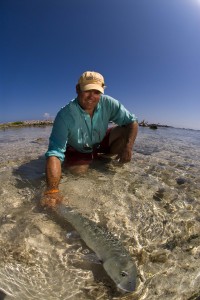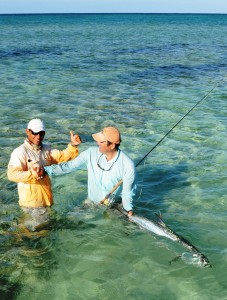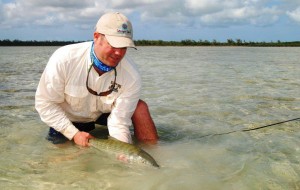Ian Davis is a saltwater addict who happens to have a pretty cool job as part of Yellow Dog Fly Fishing Adventures. He’s had a pretty interesting life on the water and he took some time to share part of that with BOTB.
Where was your last trip to the salt?
I was in the Yucatan and Belize. Heading to Grand Bahama on Nov. 2nd, then I’m headed to Bimini to fish a new operation and then I’m headed to Mangrove Cay, on operation down on Andros.
That sounds really rough there.
A lot of behind the scenes work happens on those trips that really separates Yellow Dog from a lot of the competition out there. The fact that we take all our own photos takes an enormous amount of time. Jim and I both spend a lot of time shooting the lodges and the food, I was just at the Trout Hunter in Island Park yesterday re-shooting the lodge. I didn’t even fish. I floated a couple of sections and I had an angler with me and I just let him fish, talked with the guide, talked about the hatches and it is the same thing down in the Bahamas. There no doubt it is a great job and we have a great passion for it, but a lot of these trips are hard work. You are ready to come home after your 10 days stint.
Kind of an awesome shot there.
When you are out on the water a lot, you see some strange things. Is there anything that stands out?
One time I was on the West Side of Andros and we were poling the opening of a creek and it is really muddy and silty out there. We were catching bonefish and I think this was probably April or May, and way in the back part of the flat there was this big commotion going on, lots of splashing. It looked like a big old cuda had gotten stuck in the mud and I just figured it had been chasing a bonefish and had gotten in too shallow water and was struggling to get out. The bottom was soft enough that it could probably crawl out of that mud. We weren’t worried about it. It was pretty far away. We just kept fishing and kept catching bonefish. We were fishing about another half hour and finally it started working its way towards us and it’s back was out of the water and we were both saying that it was a monster cuda and we should probably go over there and catch it and take some photos of it. We started poling over to it and it turns out it was about a 70 pound tarpon. It was literally taking a mud bath. We got up close to it and we didn’t even cast to it, at first, and it was utilizing that soft, silky west-side mud to get sea lice off of it, or just literally have a spa day. It just looked like it was having so much fun noodling through the mud like a salmon making a redd and that was really neat. I’d never seen anything like that and when we threw at it, it ate immediately. It was really fun.
Other fun stuff out on the flats. Always have a rod rigged for whatever species you want to target. Invitably, whatever you are not prepared for will roll down the pipe. I’ve seen tuna and dorado up in the Joulters in the Bahamas in four feet of water. If you didn’t have a tarpon rod, you aren’t going to have a shot at that. A close friend of mine saw a sail fish on the West Side of Andros in three feet of water. You just never expect those sorts of things, but when you have shallow water adjacent to deep water, like a lot of the Bahamas, you are going to have a wide range of species that might be coming at the boat.
That was probably a lot of fun.
What’s your current favorite rod and reel.
Nine foot 8 wt., Biiix Winston and Hatch Reels.
I know you guys love the Hatch Reels.
Yup. I’ve also always been a big fan of the Winstons. When I had my fly shop in Colorado, I sold them and I’ve continued to use them. I love the fact that they are made in Montana and they are super a good company and good people. I love the action. I think it is one of the best fish fighting tools out there. So many people focus on casting the rod and they forget that that is only half of it. You have to fight the fish. With today’s stronger tippet in flourocarbon, you can give the fish more work that folks typically do. Stu Apte is the master at that. Stu’s a good buddy of mine and we talk a lot about the proper pressure on fish. I really think that boron butt section really enables anglers to lean on their fish a little bit more and we all know that the importance of that, not only is it fun, but it is conservation based. We want to protect the species so our kids can catch them. The way to do that is to land them quickly. Flouro has aided to that, but often people are buying these wicked fast rods all the way to the tip and they are super quick and brittle and it is hard to put a good fight with that fast action rod because one head shake and it can break. The fast action rods these days are also often difficult to cast within 50′, they are just too fast. That’s what’s always brought me back to Winston. The castability and the fish fighting ability of those rods.
Spending a little bit extra on your reel is important because of the way salt eats away at our gear. I stand firmly behind the Hatch. I love that it is an encased drag system, it is sealed. I like that the foot is machined on. Battling the screws is always a bummer if they loosen up. I love that you can take the spool off and nothing falls out. Everything is attached and it doesn’t fall out. I’ve had horrendous times trying to take a reel apart, something jams or trying to change from right hand to left hand retrieve and some little spring goes flying out and lands in the water. Trip over. I love the fact that the Hatch reels are idiot proof.
There are usually a couple of people in our angling lives that really help us grow as anglers. Do you have anyone like that in your saltwater fishing career?
I would say when I had my fly shop my partner was a big steelhead fisherman and I really loved the flats. I’d go down to the Bahamas and bum around and stay at friends houses and I got really lucky and I started fishing with Charlie Neymour and Andy Smith and I couldn’t have picked two better people. They were about my age and their dad’s were the fathers of bonefishing in the Bahamas. Crazy Charlie and Ivan Neymour were really the first two guides in the Bahamas and the pioneered bonefishing in the Bahamas. So, their sons, I grew up with them. They had the same passion for it that we had for it. They weren’t conch or lobster fisherman that guided bonefish in the off season in their cousin’s boat. These guys were serious. On their days off they were fishing. That’s something that Yellow Dog always asks… “What do you do on your days off?” We want to know that they are after it and fishing just like we do. Andy and Charlie had a strong passion for big bonefish. We always want to get our numbers up that first morning, but the rest of the time we’d spend looking for big bonefish and permit and tarpon. They really set the stage for me and enabled me to understand the sport of flats fishing at a grassroots level. I wasn’t reading about it, I was sleeping on the beach and saving all my guide tips to be able to come and fish with these guys. We could only afford a couple of days with them, but we really valued that time and asked a lot of questions. Being guides ourselves we knew not to guide the guides. We let them do their thing. Some years later when I came to Yellow Dog I got to spend a lot of time with Charlie himself, Charlie Smith. That was probably where I gained the most insight on a fishes behavior. It can be so fine tuned that now I feel like if I see a fish I know if I’m going to catch it based on it’s behavior and what the previous fish did. That’s a neat thing, to have that relationship with your guide where the guide starts to turn the boat a little bit or you feel it speed up or slow down and and you look 60′ at 11:00 and there’s a fish and not a word was spoken. That’s how I’ve managed to get with the Smith family and the Neymour family. There’s not a lot of talking in the boat anymore beyond our kids and our families and maybe a little business. We aren’t pointing out fish anymore.
People doing these trips get so focused on how many fish they’ve caught. Please don’t do the math on how much each fish is costing, after flights and package and beer. That reduces your fish count. I really like to promote the cultural aspects of these destinations and first and foremost the relationships with the guides. Those can be some of the strongest relationships you’ll carry though the rest of your life and they are all wonderful people and I really consider the Neymours and the Smiths some of my closest friends. We get to see each other at the shows and throughout the winters and then when I go down there. I’m still trying to get them to come up to Montana, but haven’t had luck on that yet.
What percentage of the flies in your fly box do you tie?
For trout flies, I had a fly shop and when I sold that I pilfered about 30 years of flies. I’ll tie the basic trout flies, but I love to tie saltwater flies. I have a vice at my desk and when I’m making pre-trip or post-trip calls, which is about 30% of my time, I’m tying flies. I love the big saltwater flies. The first half of my fishing career I tied trout flies. Now, as I get a bit older I like the bigger hooks and the bigger flies. I love tying tarpon flies like variations of the toads, cockroaches and black deaths. Love bonefish flies like clouser gotchas, toad head, I still spin a lot of elk hair… I think that flies pushing water really gets their lateral lines going. I use a lot of traditional materials. Enrico Puglisi is always blowing me away with his materials. I am using a lot more EP materials in my flies and I love his his flies. He’s a big time innovator. Not only are his flies sexy, but they catch fish and are durable.
Ian showing how to take a good C&R photo here.
One of the things I love about bonefishing is all the other stuff that is associated with it. The cracked conch and the cold Kalik. Are there associations you make with bonefishing beyond the fishing?
I would say watching friends fish. I really get a kick out of watching fish describe their experience and seeing it first hand. I’m really lucky. I’ve caught a lot of bonefish and I’ve been in a lot of places where bonefish live. I never thought I’d say this, but I don’t have to catch a lot of fish to be happy. On the Henry’s Fork I fished about 20 minutes and I just really watched my buddy fish and took pictures. Photography has really taken over for me in terms of my enjoyment on the fringe. I also really enjoy watching the families associate with these destinations grow. I like watching their kids grow up. I have three young kids and like I was saying, I kind of grew up with Charlie Neymour and Andy Smith. Now we all have kids and families and it is always fun to go back to those places and see people growing up. There isn’t a lot of change in those places beyond that.
Thanks Ian.




